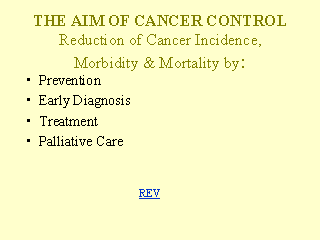Search inside of Supercourse and lectures in HTML and PPT format
 |
|

|
front |1 |2 |3 |4 |5 |6 |7 |8 |9 |10 |11 |12 |13 |14 |15 |16 |17 |18 |19 |20 |21 |22 |23 |24 |25 |26 |27 |28 |29 |30 |31 |review |
 The WHO model for cancer control is based on a public health approach to non-communicable disease control. It seeks to reduce the incidence of cancer, as well as its mortality and morbidity. To design an effective cancer control program at country level one needs to have a thorough understanding of the disease process and its epidemiology, as well as of the social and economic factors that influence how that understanding can be effectively used. That information was covered in the first lecture of this series, which should be consulted for details. The current lecture will address putting the science into practice - the interventions that are currently available for cancer control. To use the metaphor of the individual patient: one first makes a diagnosis, then selects an appropriate treatment strategy, and finally formulates a treatment plan to guide its implementation. By analogy, at country level, the first lecture deals with the “diagnosis” of the cancer problem. This lecture describes the “treatment strategy” that can be used. A final third lecture is planned to deal with how one formulates the “treatment plan” to implement the strategy at the country level. There are four principal approaches to cancer control, as listed on the slide. They must be combined into integrated programming to be effective. This lecture will examine each in detail so that the reader may gain a practical knowledge of the available interventions. |